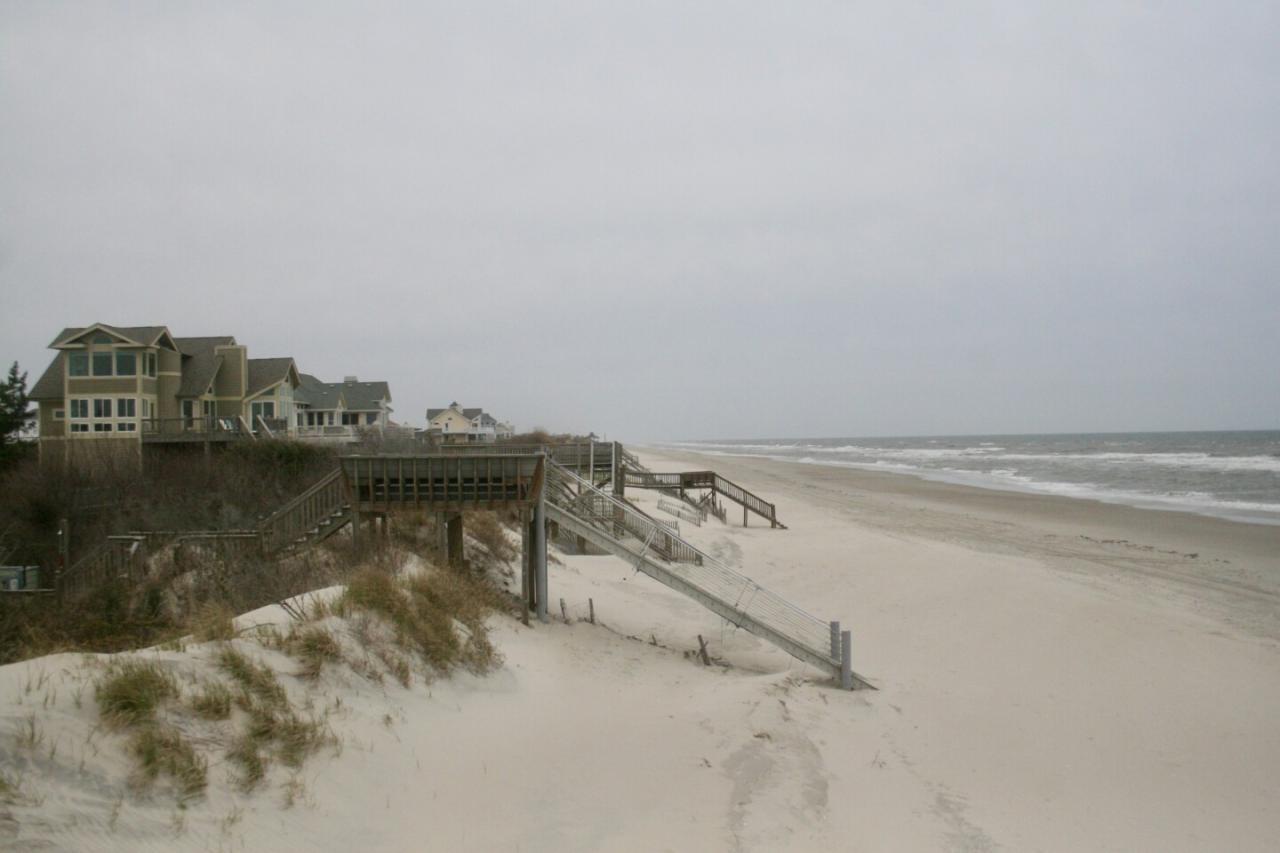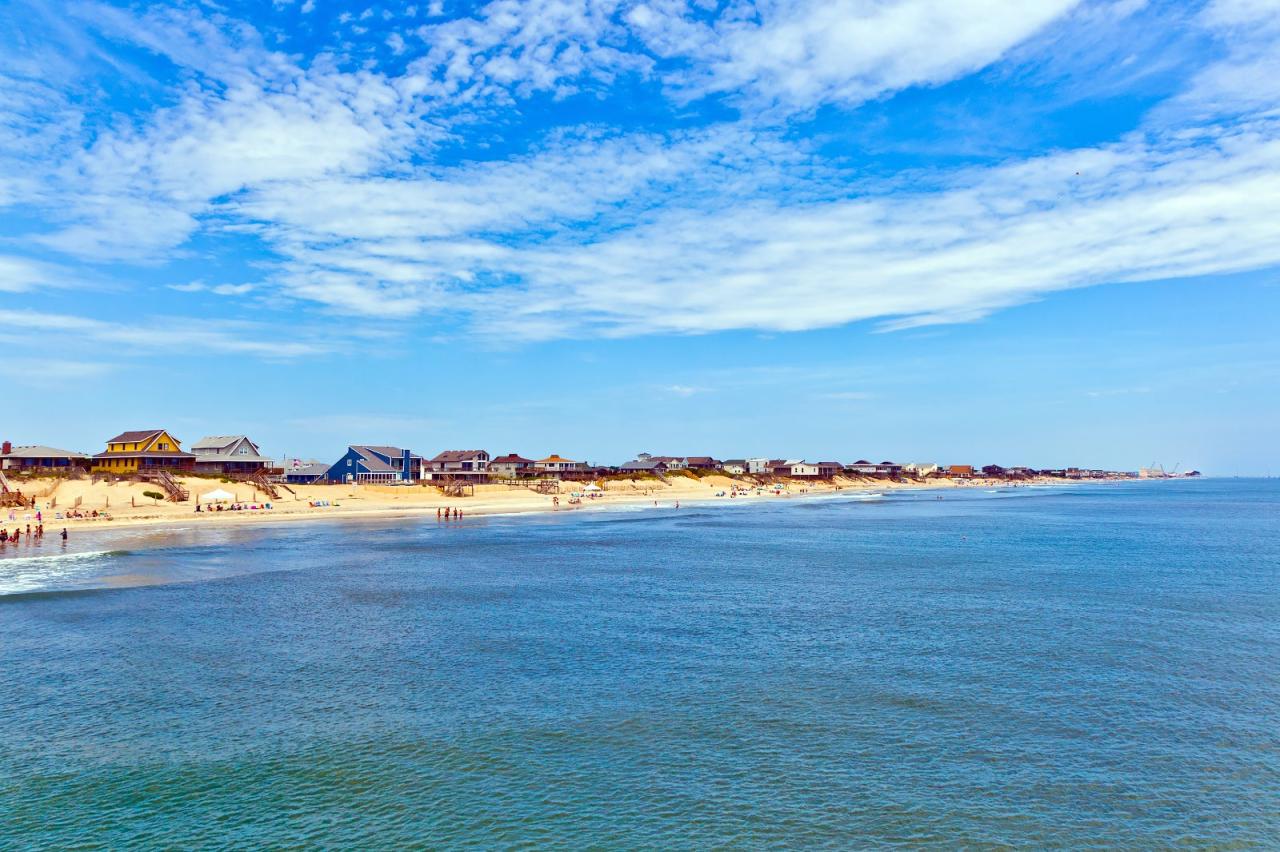Outer Banks North Carolina, a string of barrier islands along the Atlantic coast, captivates visitors with its breathtaking beauty and rich history. From pristine beaches and towering lighthouses to maritime forests and bustling fishing villages, the Outer Banks offers a diverse landscape that has shaped the region’s unique culture and identity.
The Outer Banks boasts a captivating past, marked by Native American settlements, colonial exploration, and the development of a thriving tourism industry. The region has also inspired countless works of art, literature, and music, leaving an enduring legacy on American culture.
Today, the Outer Banks continues to draw visitors seeking adventure, relaxation, and a glimpse into a bygone era.
Geography and Location

The Outer Banks, a chain of barrier islands off the coast of North Carolina, is a captivating destination renowned for its pristine beaches, diverse ecosystems, and rich history. Situated along the Atlantic Ocean, the Outer Banks extends approximately 200 miles from the Virginia border to Cape Lookout, North Carolina.
It’s a relatively isolated region, with the nearest major cities being Norfolk, Virginia, to the north and Wilmington, North Carolina, to the south.
Barrier Islands and Beaches
The Outer Banks is characterized by its distinctive barrier islands, which are long, narrow strips of land separated from the mainland by sounds or lagoons. These islands serve as natural buffers, protecting the mainland from the full force of ocean storms.
The most prominent barrier islands include Hatteras Island, Ocracoke Island, and Roanoke Island. Each island boasts unique characteristics, from the wide, sandy beaches of Hatteras Island to the quaint, historic charm of Ocracoke Island. The beaches of the Outer Banks are renowned for their beauty and recreational opportunities, offering a diverse range of activities such as swimming, sunbathing, surfing, and fishing.
Diverse Ecosystems
The Outer Banks is home to a diverse array of ecosystems, each with its own unique flora and fauna. The barrier islands support a variety of habitats, including maritime forests, salt marshes, and sand dunes. Maritime forests, characterized by their dense canopy of trees such as live oak and loblolly pine, provide shelter for a wide range of wildlife.
Salt marshes, found along the edges of the sounds and inlets, are crucial breeding grounds for fish, shellfish, and migratory birds. Sand dunes, sculpted by wind and waves, play a vital role in stabilizing the shoreline and protecting inland areas from erosion.
The recent news about bank collapse has everyone worried. It’s a complex issue, and it’s important to understand the factors that contribute to it. While it’s easy to panic, remember that there are steps you can take to protect yourself and your finances.
- Maritime Forests:These forests are home to a variety of wildlife, including deer, squirrels, rabbits, and a wide array of bird species.
- Salt Marshes:Salt marshes provide a rich habitat for a variety of invertebrates, fish, and birds. They are also important for filtering pollutants from the water.
- Sand Dunes:Sand dunes are home to a variety of plants, including sea oats, beachgrass, and dune sunflowers. They are also an important habitat for nesting sea turtles.
History and Culture
The Outer Banks has a rich and complex history, dating back centuries. The region has been shaped by Native American tribes, European colonization, and the development of tourism. The Outer Banks is steeped in history, offering glimpses into its captivating past.
Native American History
The Outer Banks was originally inhabited by various Native American tribes, including the Algonquin, the Tuscarora, and the Roanoke. These tribes lived in harmony with the natural environment, relying on fishing, hunting, and agriculture for sustenance. Archaeological evidence suggests that Native Americans have occupied the Outer Banks for thousands of years.
Colonial Settlements
The first European settlement in the Outer Banks was established in 1585 on Roanoke Island. This ill-fated colony, known as the “Lost Colony,” vanished without a trace, leaving behind a mystery that continues to fascinate historians and adventurers today. Other colonial settlements followed, including the establishment of Bath, North Carolina, in 1696, which served as the first colonial capital of the state.
Development of Tourism
The Outer Banks began to attract tourists in the late 19th century, with the development of fishing camps and summer cottages. The region’s natural beauty, pristine beaches, and abundance of outdoor recreational activities quickly made it a popular destination for vacationers.
In the 20th century, the Outer Banks experienced a significant boom in tourism, with the construction of resorts, hotels, and other amenities. Today, tourism is the primary industry of the Outer Banks, driving the local economy and shaping the region’s culture.
Tourism and Recreation
The Outer Banks is a renowned tourist destination, attracting visitors from all over the world. Its pristine beaches, iconic lighthouses, and diverse outdoor recreational activities make it a popular choice for families, couples, and adventurers alike.
Popular Tourist Attractions

The Outer Banks offers a wide array of tourist attractions, each with its own unique charm. Some of the most popular include:
- Beaches:The Outer Banks is famous for its pristine beaches, which stretch for miles along the Atlantic Ocean. Popular beaches include Kitty Hawk, Nags Head, and Hatteras Island.
- Lighthouses:The Outer Banks is home to several historic lighthouses, including the Bodie Island Lighthouse, the Cape Hatteras Lighthouse, and the Currituck Beach Lighthouse. These lighthouses offer stunning views of the coast and are popular destinations for photography and sightseeing.
- Historical Sites:The Outer Banks is rich in history, with numerous historical sites to explore. These include the Wright Brothers National Memorial, the Roanoke Island Festival Park, and the Fort Raleigh National Historic Site.
- Nature Preserves:The Outer Banks is home to several nature preserves, including the Pea Island National Wildlife Refuge, the Alligator River National Wildlife Refuge, and the Jockey’s Ridge State Park. These preserves offer opportunities for hiking, birdwatching, and wildlife viewing.
Recreational Activities
The Outer Banks offers a wide variety of recreational activities for visitors of all ages and interests. Some of the most popular include:
- Swimming:The Outer Banks is known for its warm waters and beautiful beaches, making it a perfect destination for swimming.
- Surfing:The Outer Banks is a popular destination for surfers, with consistent waves and a variety of surf breaks.
- Fishing:The Outer Banks is a renowned fishing destination, with abundant opportunities for both inshore and offshore fishing.
- Boating:The Outer Banks offers a variety of boating opportunities, from leisurely cruises to exciting fishing trips.
- Hiking:The Outer Banks is home to several hiking trails, offering opportunities to explore the region’s diverse ecosystems.
- Birdwatching:The Outer Banks is a haven for birdwatchers, with a wide variety of migratory birds visiting the region each year.
Economy and Development: Outer Banks North Carolina
The economy of the Outer Banks is primarily driven by tourism, fishing, and real estate. The region’s natural beauty, pristine beaches, and abundant outdoor recreational activities attract visitors from all over the world, making tourism the dominant industry. However, the Outer Banks faces challenges and opportunities in terms of economic development, environmental sustainability, and infrastructure.
Primary Industries
- Tourism:Tourism is the primary industry of the Outer Banks, generating significant revenue and employment opportunities. The region’s attractions, including its beaches, lighthouses, and historical sites, draw millions of visitors each year.
- Fishing:Fishing has been a vital part of the Outer Banks economy for centuries. The region’s waters are home to a variety of fish species, including bluefin tuna, marlin, and mahi-mahi.
- Real Estate:The Outer Banks has a thriving real estate market, with a mix of residential and commercial properties. The region’s popularity as a tourist destination and its desirable lifestyle have fueled demand for housing and vacation rentals.
Challenges and Opportunities, Outer banks north carolina
The Outer Banks faces a number of challenges in terms of economic development, environmental sustainability, and infrastructure. These include:
- Seasonal Economy:The Outer Banks economy is highly seasonal, with a peak season during the summer months. This can lead to fluctuations in employment and business activity.
- Environmental Sustainability:The Outer Banks is vulnerable to the impacts of climate change, including sea level rise, erosion, and storm surges. The region faces challenges in balancing economic development with environmental protection.
- Infrastructure:The Outer Banks’ infrastructure, including its roads, bridges, and utilities, is often strained by the influx of tourists during peak season. The region faces challenges in expanding and maintaining its infrastructure to meet the needs of a growing population.
Future of the Outer Banks
The future of the Outer Banks is likely to be shaped by a number of factors, including the impacts of climate change, the growth of the tourism industry, and the development of new technologies. The region has a strong foundation in tourism, and it is likely that this industry will continue to play a significant role in the Outer Banks economy.
However, the region will need to address the challenges of environmental sustainability and infrastructure development to ensure its long-term prosperity.
Natural Environment and Wildlife
The Outer Banks is a haven for a diverse array of wildlife, with its unique ecosystems providing habitat for migratory birds, marine mammals, reptiles, and amphibians. The region’s natural environment plays a crucial role in supporting this rich biodiversity, making it a significant ecological area.
Bank collapses can be scary, especially if you have money in one. It’s important to understand the risks involved and how to protect yourself. You can learn more about the factors that can lead to a bank collapse and what to do if it happens on the MDBP website.
Diverse Wildlife
The Outer Banks is home to a variety of wildlife, including:
- Migratory Birds:The Outer Banks is a major stopover point for migratory birds, including shorebirds, waterfowl, and raptors.
- Marine Mammals:The waters off the Outer Banks are home to a variety of marine mammals, including dolphins, whales, and seals.
- Reptiles and Amphibians:The Outer Banks is home to a variety of reptiles and amphibians, including sea turtles, snakes, lizards, and frogs.
Ecological Significance
The Outer Banks is ecologically significant for a number of reasons, including:
- Habitat for Endangered Species:The Outer Banks provides habitat for a number of endangered or threatened species, including the loggerhead sea turtle, the piping plover, and the red wolf.
- Breeding Grounds:The Outer Banks is an important breeding ground for a variety of fish, shellfish, and migratory birds.
- Protection from Storms:The barrier islands of the Outer Banks protect the mainland from the full force of ocean storms.
Environmental Challenges
The Outer Banks faces a number of environmental challenges, including:
- Erosion:The barrier islands of the Outer Banks are constantly being eroded by wind and waves.
- Sea Level Rise:Sea level rise is a major threat to the Outer Banks, as it can lead to increased flooding and erosion.
- Pollution:Pollution from sources such as sewage, runoff, and oil spills can harm the Outer Banks’ ecosystems.
Wrap-Up
The Outer Banks offers a captivating blend of natural beauty, historical significance, and modern recreation. Whether you’re seeking a relaxing beach vacation, an adrenaline-pumping surf session, or a journey into the past, the Outer Banks has something for everyone. As you explore this remarkable destination, you’ll discover a vibrant community that cherishes its heritage and embraces the wonders of the natural world.











